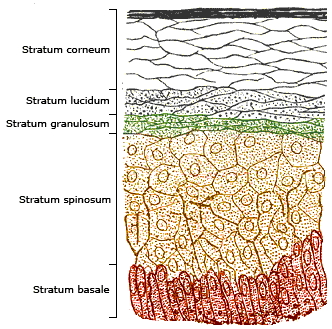stratum lucidum on:
[Wikipedia]
[Google]
[Amazon]

 The stratum lucidum (Latin, 'clear layer') is a thin, clear layer of dead skin cells in the
The stratum lucidum (Latin, 'clear layer') is a thin, clear layer of dead skin cells in the
 The stratum lucidum (Latin, 'clear layer') is a thin, clear layer of dead skin cells in the
The stratum lucidum (Latin, 'clear layer') is a thin, clear layer of dead skin cells in the epidermis
The epidermis is the outermost of the three layers that comprise the skin, the inner layers being the dermis and Subcutaneous tissue, hypodermis. The epidermis layer provides a barrier to infection from environmental pathogens and regulates the ...
named for its translucent appearance under a microscope
A microscope () is a laboratory instrument used to examine objects that are too small to be seen by the naked eye. Microscopy is the science of investigating small objects and structures using a microscope. Microscopic means being invisibl ...
. It is readily visible by light microscopy only in areas of thick skin, which are found on the palms of the hands and the soles of the feet.
Located between the stratum granulosum
The stratum granulosum (or granular layer) is a thin layer of cells in the epidermis lying above the stratum spinosum and below the stratum corneum ( stratum lucidum on the soles and palms).James, William; Berger, Timothy; Elston, Dirk (2005) '' ...
and stratum corneum
The stratum corneum (Latin for 'horny layer') is the outermost layer of the epidermis. The human stratum corneum comprises several levels of flattened corneocytes that are divided into two layers: the ''stratum disjunctum'' and ''stratum compac ...
layers, it is composed of three to five layers of dead, flattened keratinocytes
Keratinocytes are the primary type of cell found in the epidermis, the outermost layer of the skin. In humans, they constitute 90% of epidermal skin cells.
Basal cells in the basal layer (''stratum basale'') of the skin are sometimes referre ...
.McGrath, J.A.; Eady, R.A.; Pope, F.M. (2004). ''Rook's Textbook of Dermatology'' (Seventh Edition). Blackwell Publishing. Pages 3.8. .Tortora, Gerard; Derrickson, Bryan; Principles of Anatomy and Physiology (2009)152 John Wiley & Sons Inc, Hoboken, NJ . The keratinocytes of the stratum lucidum do not feature distinct boundaries and are filled with eleidin, an intermediate form of keratin
Keratin () is one of a family of structural fibrous proteins also known as ''scleroproteins''. Alpha-keratin (α-keratin) is a type of keratin found in vertebrates. It is the key structural material making up scales, hair, nails, feathers, ...
. They are surrounded by an oily substance that is the result of the exocytosis
Exocytosis () is a form of active transport and bulk transport in which a cell transports molecules (e.g., neurotransmitters and proteins) out of the cell ('' exo-'' + '' cytosis''). As an active transport mechanism, exocytosis requires the use ...
of lamellar bodies accumulated while the keratinocytes are moving through the stratum spinosum
The stratum spinosum (or spinous layer/prickle cell layer) is a layer of the epidermis found between the stratum granulosum and stratum basale. This layer is composed of polyhedral keratinocytes. These are joined with desmosomes. Their spiny ( ...
and stratum granulosum.
The thickness of the stratum lucidum is controlled by the rate of mitosis
In cell biology, mitosis () is a part of the cell cycle in which replicated chromosomes are separated into two new nuclei. Cell division by mitosis gives rise to genetically identical cells in which the total number of chromosomes is maint ...
(division) of the epidermal cells. Melanosomes in the stratum basale
The ''stratum basale'' (basal layer, sometimes referred to as ''stratum germinativum'') is the deepest layer of the five layers of the epidermis, the external covering of skin in mammals.
The ''stratum basale'' is a single layer of columnar or ...
determine the darkness of the stratum lucidum.
References
{{integumentary system Skin anatomy Epithelial cells